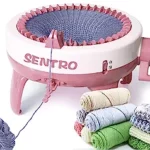So, you're super excited to start your first knitting project, and you've got all the materials laid out in front of you. Yarn? Check. Needles? Check. Pattern? Check. As you read through the pattern instructions, you come across the magical words "cast on 50 stitches." Easy peasy, right? Wrong.
You eagerly pick up your yarn, trying to channel your inner knitting pro. But as you attempt to make a slip knot, your fingers seem to have a mind of their own. The yarn slips and slides, and your attempts at creating a knot look more like a tangled mess.
In a moment of desperation, you call your knitting-savvy friend for help. They chuckle at your predicament and kindly offer to walk you through the slip knot process. "It's just like tying your shoelaces," they say, trying not to laugh too hard.
After a few tries, you finally manage to make a slip knot that resembles something vaguely knot-like. Success! You feel a rush of accomplishment like you've just won a knitting Olympics.
From that day on, you realize the importance of knowing how to make a slip knot. It's the gateway to the wonderful world of knitting – a world of cozy scarves, cute baby booties, and perhaps, one day, those intricate cable sweaters you dream of knitting. So, with newfound confidence and a trusty slip knot in your knitting arsenal, you're ready to conquer the knitting world, one stitch at a time. Happy knitting, and may your slip knots always be knot-worthy!
How to Make a Slip Knot for Knitting: The Essential First Step for Every Knitter
As a novice knitter, the world of knitting can seem both exciting and overwhelming. Before you dive into the intricate patterns and cozy projects, there's one fundamental skill you must master: making a slip knot. The slip knot is the very first step in knitting, acting as the anchor for your stitches and setting the stage for your knitting journey. In this comprehensive guide, we'll walk you through the process of creating a slip knot, explore its importance in knitting, and offer helpful tips to ensure your slip knots are knot-ably perfect.
What is a Slip Knot in Knitting?
A slip knot is a simple knot used to create a loop in the yarn, providing a starting point for casting on stitches. It is an essential skill for every knitter, as it forms the foundation for your knitting projects.
Why is the Slip Knot Important in Knitting?
The slip knot serves several important purposes in knitting:
- Starting Point: The slip knot provides the initial loop needed to begin casting on stitches onto the knitting needle.
- Adjustable Size: By adjusting the tension of the slip knot, you can control the size of the loop, ensuring a comfortable fit for your knitting needle.
- Secure Anchor: The slip knot securely anchors the yarn, preventing it from unraveling as you start your knitting.
How to Make a Slip Knot - Step-by-Step Instructions
Follow these simple steps to create a slip knot for knitting:
Step 1: Prepare the Yarn
Hold the working end of the yarn in your dominant hand, leaving a short tail of about 4 to 6 inches. The longer end of the yarn will be attached to the yarn ball.
Step 2: Create a Loop
Form a loop with the yarn by crossing the longer end over the shorter tail. The loop should resemble a pretzel shape, with the tail on top.
Step 3: Pass the Tail Through
Using your fingers, insert the tail end of the yarn through the loop from the bottom and pull it slightly to tighten the loop around the tail. This forms a basic knot.
Step 4: Adjust the Loop
Slide the loop up or down the tail end of the yarn to adjust the size of the loop. The loop should be large enough to fit your knitting needle comfortably.
Step 5: Tighten the Knot
Hold the loop with one hand and pull the longer end of the yarn with the other hand to tighten the knot. Make sure it is secure but not too tight to allow movement of the loop.
Tips for Perfecting Your Slip Knot
Creating a slip knot may seem simple, but a few tips can help you master this foundational knitting skill:
- Loose Tail: Leave a loose tail when starting the slip knot to ensure you have enough yarn to weave in later.
- Adjustable Loop: Make the loop slightly larger than your knitting needle to allow ease when casting on stitches.
- Gentle Tension: When pulling the longer end of the yarn to tighten the knot, use a gentle, steady pull to avoid pulling it too tightly.
- Practice Makes Perfect: Practice making slip knots with scrap yarn until you feel comfortable with the technique.
Common Mistakes When Making a Slip Knot
Even the simplest knitting skills can have their challenges. Here are some common mistakes to avoid when making a slip knot:
- Tangled Knot: Make sure the yarn forms a smooth loop without any tangles or twists to create a clean slip knot.
- Tight Knot: Avoid pulling the yarn too tightly, as this can hinder the movement of the loop when casting on stitches.
- Small Loop: Ensure the loop is large enough to comfortably fit your knitting needle. A too-tight loop can make casting on difficult.
Importance of a Neat Slip Knot
A well-made slip knot sets the tone for your knitting project. Not only does it serve as the foundation for your stitches, but a neat slip knot also makes the initial casting on process easier and more enjoyable. Additionally, a clean slip knot ensures that the starting edge of your knitting looks polished and tidy.
Incorporating Slip Knots in Knitting
Once you've mastered making a slip knot, you can explore a variety of knitting projects and techniques that rely on this essential skill:
- Casting On: The slip knot is the first step in casting on stitches for all knitting projects.
- Changing Colors: When switching yarn colors in knitting, you often start with a slip knot to secure the new yarn.
- Provisional Cast On: In certain knitting techniques, like the provisional cast on, you create a temporary slip knot to later unravel and continue knitting.
Conclusion
As a knitter, learning how to make a slip knot is the gateway to a world of creativity and craftsmanship. With a simple loop and a gentle tug, you anchor your yarn, setting the stage for your knitting adventure. The slip knot may be a small step, but its significance in knitting cannot be understated. So, with yarn in hand and a sense of excitement, embrace the art of the slip knot and let it lead you into the beautiful world of knitting. Happy knitting, one slip knot at a time!
To find out more about knitting, please visit any of the following areas:
- How to sew together knitting
- What is brioche knitting
- How to join yarn in knitting
- How to join in the round knitting
- How to finish a knitting scarf
- How to make a slip knot for knitting
- How to switch colors knitting
- How to hold yarn when knitting
- What does kfb mean in knitting
- How to fix a dropped stitch in knitting
- How to hold knitting needles
- What is frogging in knitting?
- How to change colors in knitting
- How to count rows in knitting
- How to increase in knitting
- How to slip stitch knitting
- How to yarn over in knitting
- What is a knitting loom?
- How to make bobbles in knitting?
- Where can I buy sentro knitting machine?
- What can you make with a sentro knitting machine?
- Cricut Hat Press: A Comprehensive Guide on Usage - August 13, 2023
- Unlocking Creativity with the Cricut Joy: A Comprehensive Guide - August 12, 2023
- The Ultimate Guide to the Cricut Maker Bundle - August 11, 2023





